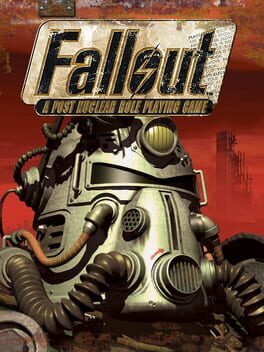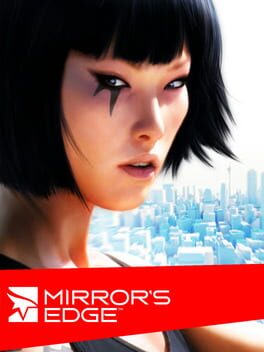JRCT3E
1997
i'm not gonna bother to write a full Fallout 1 Is Garbage And Here Is Why-style review for what is an overrated game so here are my notes:
- character creation is so easy to fuck up because of how unbalanced it is. you can make a run more excruciating if you dont put enough points in agility, meanwhile endurance is just fucking useless, and how is charisma a dump stat when speech is one of the most important skills in the game???????
- inventory management and item use is so clunky and restrictive. good luck finding the right spot to use your rope
- have fun being softlocked in small rooms because your dog npc blocks the doorway. have fun opening doors anyway if it doesn't face the screen
- side quests are not marked in your status screen. these side quests are way more important to get basically essential loot ( e.g. power armor). they are also really easy to miss
- the game is honestly so glitchy if this was a bethesda game there would be gamer rage. questimportant npcs can die if you like leave the room. its exacerbated on modern computers. i had frequent mouse locks
- the time limit is annoying. not big enough to be important but still an unneccessary source of unknown stress for new players. why is it there?
- i found it kinda annoying that new vegas only gives you new perks every 2 levels. then fallout 1 gives you perks every THREE. FUCKING THREE. with levelling up being so goddamn slow its fuckyoutown
- the tone is way more serious and less tongue in cheek. for me personally too serious, i really miss having elvis impersonators and wacky social experiments. then it turned out you get humor at random encounters? didnt hbomb fucking lambast fallout 3 for doing that??????
- backtracking is annoying because you can move the camera past your characters but if you click on a space characters wont go there. theyll onky go if your camera contains your characters
- you will straight up not know what item to use on a thing unless you read a guide. have fun alt-tabbing while figuring out how to disable the force-fields in the middle of a countdown. AND THEN THE SOLUTIONS DONT WORK ANYWAY BECAUSE FUCK YOU.
well fuck you too fallout 1. anyone who says this hasn't aged to others with way less free time and more choice in other good games should be shot in the head vegas-style to induce amnesia and then forced to figure out how this game works without guides. for all the rest who do respect their time, go to fallout new vegas.
- character creation is so easy to fuck up because of how unbalanced it is. you can make a run more excruciating if you dont put enough points in agility, meanwhile endurance is just fucking useless, and how is charisma a dump stat when speech is one of the most important skills in the game???????
- inventory management and item use is so clunky and restrictive. good luck finding the right spot to use your rope
- have fun being softlocked in small rooms because your dog npc blocks the doorway. have fun opening doors anyway if it doesn't face the screen
- side quests are not marked in your status screen. these side quests are way more important to get basically essential loot ( e.g. power armor). they are also really easy to miss
- the game is honestly so glitchy if this was a bethesda game there would be gamer rage. questimportant npcs can die if you like leave the room. its exacerbated on modern computers. i had frequent mouse locks
- the time limit is annoying. not big enough to be important but still an unneccessary source of unknown stress for new players. why is it there?
- i found it kinda annoying that new vegas only gives you new perks every 2 levels. then fallout 1 gives you perks every THREE. FUCKING THREE. with levelling up being so goddamn slow its fuckyoutown
- the tone is way more serious and less tongue in cheek. for me personally too serious, i really miss having elvis impersonators and wacky social experiments. then it turned out you get humor at random encounters? didnt hbomb fucking lambast fallout 3 for doing that??????
- backtracking is annoying because you can move the camera past your characters but if you click on a space characters wont go there. theyll onky go if your camera contains your characters
- you will straight up not know what item to use on a thing unless you read a guide. have fun alt-tabbing while figuring out how to disable the force-fields in the middle of a countdown. AND THEN THE SOLUTIONS DONT WORK ANYWAY BECAUSE FUCK YOU.
well fuck you too fallout 1. anyone who says this hasn't aged to others with way less free time and more choice in other good games should be shot in the head vegas-style to induce amnesia and then forced to figure out how this game works without guides. for all the rest who do respect their time, go to fallout new vegas.
2008
For a long time, Sonic fans have long wondered why SEGA didn’t do the obvious thing and commission Sonic Mania 2 from its developers. Turns out, they did try to. However, the Mania developers decided they didn’t want to retread old ground by making a 2D Sonic game, and decided to take a bold, creative risk. I really want to applaud the developers for trying to make a fresh, new take on a 3D platformer that’s momentum based and also puts the emphasis on character movement. But I really can’t in good conscience recommend this game to anyone but the biggest fans of speedrunning, momentum-based games, pre-analog camera control platformers, and Sonic.
A big break of traditional game design Penny’s Big Breakaway does is breaking away from using the second stick as camera control. Instead, you use the stick to control Penny’s Yo-Yo. On paper, this should give you way more freedom of movement than just double-jumping or dashing or spinning via contextual or different button controls: for instance, you can quickly dash in a direction that’s not the one your left stick is heading towards, allowing you some handy emergency clutches. It’s basically a super-powered version of the advanced cap-jump trick you can do in Mario Odyssey, promoted to a main starring role.
However, it’s also that removal of camera control that screws up the hypothetical elegance of this new movement system. The camera automatically changes viewpoint in order to show what’s ahead. Again, on paper, it’s not bad (it makes hunting for collectible an actual challenge of reading the road in front of you ahead and anticipate where possible path deviations might lie). But your constantly changing viewpoint that’s out of your control makes it very hard to accurately move both sticks in the direction you want them to go.
These things make for a very steep difficulty curve, that will ensure that most players will not nail these gameplay mechanics by the time the credits roll. I’ve had a nice time of reaching 80% item completion on my first runthrough, but I definitely struggled in the later levels to keep a nice flow going. It was a harsh reminder that playing fast, momentum-based games like Sonic elegantly is a skill that takes a long time to master, and I do not fault most players to give up before that point. However, it’s unfortunate that Penny’s Big Breakaway lacks the precision itself to make the road to mastery a great experience for those who do want to engage in the challenge. Lots of people have already commented on the bugs which can seriously screw up your game flow, but even beyond that it lacks the clearly communicated nuance that a game like Celeste has in your movements and punishments that makes platformers like these tough but fair.
To wrap it up, I really wish I could give this game four stars. I’m a huge fan of the work of the developers, and their commitment to take the ambitious and revolutionary path, especially for what is essentially their first 3D game. I just hope that they’ll hone in on the unique potential of this game and polish it in their next project. Like Sonic the Hedgehog, whose first game showed potential that was only really realized in the sequels, Penny and Yo-Yo need to have a little more time to practice their skills in the wings.
A big break of traditional game design Penny’s Big Breakaway does is breaking away from using the second stick as camera control. Instead, you use the stick to control Penny’s Yo-Yo. On paper, this should give you way more freedom of movement than just double-jumping or dashing or spinning via contextual or different button controls: for instance, you can quickly dash in a direction that’s not the one your left stick is heading towards, allowing you some handy emergency clutches. It’s basically a super-powered version of the advanced cap-jump trick you can do in Mario Odyssey, promoted to a main starring role.
However, it’s also that removal of camera control that screws up the hypothetical elegance of this new movement system. The camera automatically changes viewpoint in order to show what’s ahead. Again, on paper, it’s not bad (it makes hunting for collectible an actual challenge of reading the road in front of you ahead and anticipate where possible path deviations might lie). But your constantly changing viewpoint that’s out of your control makes it very hard to accurately move both sticks in the direction you want them to go.
These things make for a very steep difficulty curve, that will ensure that most players will not nail these gameplay mechanics by the time the credits roll. I’ve had a nice time of reaching 80% item completion on my first runthrough, but I definitely struggled in the later levels to keep a nice flow going. It was a harsh reminder that playing fast, momentum-based games like Sonic elegantly is a skill that takes a long time to master, and I do not fault most players to give up before that point. However, it’s unfortunate that Penny’s Big Breakaway lacks the precision itself to make the road to mastery a great experience for those who do want to engage in the challenge. Lots of people have already commented on the bugs which can seriously screw up your game flow, but even beyond that it lacks the clearly communicated nuance that a game like Celeste has in your movements and punishments that makes platformers like these tough but fair.
To wrap it up, I really wish I could give this game four stars. I’m a huge fan of the work of the developers, and their commitment to take the ambitious and revolutionary path, especially for what is essentially their first 3D game. I just hope that they’ll hone in on the unique potential of this game and polish it in their next project. Like Sonic the Hedgehog, whose first game showed potential that was only really realized in the sequels, Penny and Yo-Yo need to have a little more time to practice their skills in the wings.
2005
Katamari Damacy was one of the pinnacles of the PS2-era of gaming, a time where technological advancements had finally made ambitious and novel game concepts possible without too many restraints, but also when the cost of development hadn’t risen so much that big game studios still greenlit such projects. But even this period of gaming wasn’t a bastion freed from the yokes of capitalism. Creatives still needed to grease and gaslight executives into greenlighting such creative projects, and if that project became a meteoric success, said studio execs wanted to milk the shit out of that success until all the magic had evaporated. Such was the fate that Keita Takahashi, lead designer of the Damacy games, found himself in.
We Love Katamari is a blatant and self-aware reaction on the roll-away success of Katamari Damacy. Taking place after the first game, instead of reacting with abject horror at the rolling-up of Earth by the King of All Cosmos, mankind has now become fans of the King and ask him for random katamari favours. The King, bored by the prospect of the job but not immune to even the most superficial praise, sends his son and cousins to do the fanservice for him.
It is a satirical frame to what is basically the same gameplay as the previous game. You roll your ball via manipulating both control sticks independently, adhesing small objects to your ball in order to grow it so it can stick to even larger objects. Katamari Damacy used a very logical progression of scale: with every level, you would start with increasingly larger balls until at the final level, you would roll up the entire world. We Love Katamari trades this progression for variety; next to the standard missions akin to the previous games, you are also asked to roll up different types of items like fireflies or snow or tyres, in order to satiate the fans.
And the fans will never be satisfied. Even if you roll up a mission with a high score, you will be chastised by them for not living up to the impossible expectations that they have cooked up in their dreams. It makes them downright more dismissive than even the King, contender for Worst Father in Video Games.
This frame, which would be downright cynical if not for the same absurdist vibe as the previous game, puts you in the shoes of the creator. You feel like, in a way, you’ve been there before.. Even if it’s “”””objectively”””” a better game with more varied missions, a higher difficulty and even more swag for your player characters, this game can’t quite capture the same glee and surprise as the original game because it’s obviously not an original game. It is still a great game, don’t get me wrong, but We Love Katamari also wants you to move on and find joy in the unexpected, rather than the tried and true.
We Love Katamari is a blatant and self-aware reaction on the roll-away success of Katamari Damacy. Taking place after the first game, instead of reacting with abject horror at the rolling-up of Earth by the King of All Cosmos, mankind has now become fans of the King and ask him for random katamari favours. The King, bored by the prospect of the job but not immune to even the most superficial praise, sends his son and cousins to do the fanservice for him.
It is a satirical frame to what is basically the same gameplay as the previous game. You roll your ball via manipulating both control sticks independently, adhesing small objects to your ball in order to grow it so it can stick to even larger objects. Katamari Damacy used a very logical progression of scale: with every level, you would start with increasingly larger balls until at the final level, you would roll up the entire world. We Love Katamari trades this progression for variety; next to the standard missions akin to the previous games, you are also asked to roll up different types of items like fireflies or snow or tyres, in order to satiate the fans.
And the fans will never be satisfied. Even if you roll up a mission with a high score, you will be chastised by them for not living up to the impossible expectations that they have cooked up in their dreams. It makes them downright more dismissive than even the King, contender for Worst Father in Video Games.
This frame, which would be downright cynical if not for the same absurdist vibe as the previous game, puts you in the shoes of the creator. You feel like, in a way, you’ve been there before.. Even if it’s “”””objectively”””” a better game with more varied missions, a higher difficulty and even more swag for your player characters, this game can’t quite capture the same glee and surprise as the original game because it’s obviously not an original game. It is still a great game, don’t get me wrong, but We Love Katamari also wants you to move on and find joy in the unexpected, rather than the tried and true.
I first played the original The World Ends With You through its Switch-reworking. Back then, TWEWY had basically become an artifact of a very specific time: it had a very contemporary setting of fashion-hip Shibuya, with themes of modern life loneliness at the advent of phones. It was a peek into a time when anime was growing but not yet really mainstream, and all the little gems could be found on the DS.
Then, the unlikely sequel came in a changed world. Now, the game is competing with anime and RPGs being more mainstream, experimental games are dime a dozen on even the Playstation 4 store thanks to indies, and even Kingdom Hearts 3 looks like a big budget Pixar movie. In this atmosphere, Neo The World Ends With You tries to go big while also trying to stay true to its own idiosyncrasies, and the result is a game out of time.
The game puts its best feet forward thanks to the great basic combat loop, translating the iconic fast-paced and unique pin gameplay. You now play as a party instead of two characters, and instead of touch screen controls use your normal controller to (rapid)-tap, hold or single-press a button to activate a pin, each pin getting assigned to one input (with the exception of the B-button being reserved for dodging, the L-stick for moving and the R-stick for locking onto an enemy). Complementing this setup, and enabling the theme of teamwork cooperation, is the combo system: successfully attacking with one character eventually pops up a short combo timer, and if you attack with another character, you build up a combo percentage. Hit hundred-percentiles, and you can launch a strong combo attack. It's a satisfying flow that keeps combat fast paced, especially once you find pins that work well together.
Unfortunately, it is the meta-game that stretches this fun gameplay into an odious loop. If you get good at the game, you’ll quickly run into limitations: pins get stronger by levelling them up, but there’s a cap on how many levels they can gain (including levels via evolution) and after that they don’t get stronger. Thus, you’ll need to swap them out for pins with a higher base power on level one. Unfortunately, they will run out and be replaced by Uber-pins, which you can only equip one (or two) of at a time. So, while this meta-system encourages you to experiment by swapping out pins constantly in order to level them up, eventually you will run out of fun pins to swap.
It is emblematic of NEO: TWEWY’s ethos of taking everything unique it can from the original and stretching it to its breaking point. You’ll quickly grow tired of the return of Shibuya, as the glacial pacing of the story means you’ll be revisiting the same streets over and over again, punctuated by the inclusion of a bare-bones time travel mechanic, making you even replay parts of the mission again and again.
Add in a story that in the middle is blatantly padded and often forgets about the new characters in favour of its lore/politicking, a massive need to grind for the best items to unlock, and a chain-encounter mechanic that just begs you to balloon the playtime even further, and the magic of the original quickly evaporates behind this extremely mixed experience. NEO: The World Ends With You proves that certain great things were lightning caught in a bottle, and it would be folly to try to bank on these wonders.
Then, the unlikely sequel came in a changed world. Now, the game is competing with anime and RPGs being more mainstream, experimental games are dime a dozen on even the Playstation 4 store thanks to indies, and even Kingdom Hearts 3 looks like a big budget Pixar movie. In this atmosphere, Neo The World Ends With You tries to go big while also trying to stay true to its own idiosyncrasies, and the result is a game out of time.
The game puts its best feet forward thanks to the great basic combat loop, translating the iconic fast-paced and unique pin gameplay. You now play as a party instead of two characters, and instead of touch screen controls use your normal controller to (rapid)-tap, hold or single-press a button to activate a pin, each pin getting assigned to one input (with the exception of the B-button being reserved for dodging, the L-stick for moving and the R-stick for locking onto an enemy). Complementing this setup, and enabling the theme of teamwork cooperation, is the combo system: successfully attacking with one character eventually pops up a short combo timer, and if you attack with another character, you build up a combo percentage. Hit hundred-percentiles, and you can launch a strong combo attack. It's a satisfying flow that keeps combat fast paced, especially once you find pins that work well together.
Unfortunately, it is the meta-game that stretches this fun gameplay into an odious loop. If you get good at the game, you’ll quickly run into limitations: pins get stronger by levelling them up, but there’s a cap on how many levels they can gain (including levels via evolution) and after that they don’t get stronger. Thus, you’ll need to swap them out for pins with a higher base power on level one. Unfortunately, they will run out and be replaced by Uber-pins, which you can only equip one (or two) of at a time. So, while this meta-system encourages you to experiment by swapping out pins constantly in order to level them up, eventually you will run out of fun pins to swap.
It is emblematic of NEO: TWEWY’s ethos of taking everything unique it can from the original and stretching it to its breaking point. You’ll quickly grow tired of the return of Shibuya, as the glacial pacing of the story means you’ll be revisiting the same streets over and over again, punctuated by the inclusion of a bare-bones time travel mechanic, making you even replay parts of the mission again and again.
Add in a story that in the middle is blatantly padded and often forgets about the new characters in favour of its lore/politicking, a massive need to grind for the best items to unlock, and a chain-encounter mechanic that just begs you to balloon the playtime even further, and the magic of the original quickly evaporates behind this extremely mixed experience. NEO: The World Ends With You proves that certain great things were lightning caught in a bottle, and it would be folly to try to bank on these wonders.
2022





